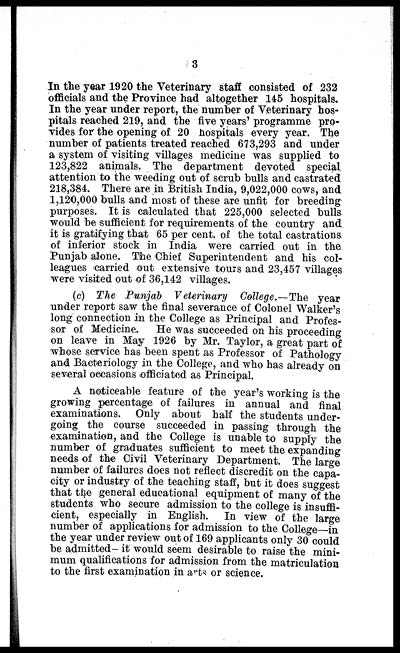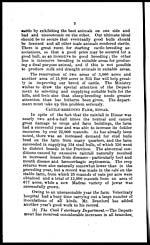Medicine - Veterinary > Civil Veterinary Departments > 1894-1932 - Annual report of the Punjab Veterinary College and of the Civil Veterinary Department, Punjab > 1926-1932 > 1926-1927 - Annual report on the Punjab Veterinary College, Civil Veterinary Department, Punjab, and the Government cattle farm, Hissar, for the year 1926-27
(136) Page 3
Download files
Individual page:
Thumbnail gallery: Grid view | List view

3
In the year 1920 the Veterinary staff consisted of 232
officials and the Province had altogether 145 hospitals.
In the year under report, the number of Veterinary hos-
pitals reached 219, and the five years' programme pro-
vides for the opening of 20 hospitals every year. The
number of patients treated reached 673,293 and under
a system of visiting villages medicine was supplied to
123,822 animals. The department devoted special
attention to the weeding out of scrub bulls and castrated
218,384. There are in British India, 9,022,000 cows, and
1,120,000 bulls and most of these are unfit for breeding
purposes. It is calculated that 225,000 selected bulls
would be sufficient for requirements of the country and
it is gratifying that 65 per cent. of the total castrations
of inferior stock in India were carried out in the
Punjab alone. The Chief Superintendent and his col-
leagues carried out extensive tours and 23,457 villages
were visited out of 36,142 villages.
(c) The Punjab Veterinary College.—The year
under report saw the final severance of Colonel Walker's
long connection in the College as Principal and Profes-
sor of Medicine. He was succeeded on his proceeding
on leave in May 1926 by Mr. Taylor, a great part of
whose service has been spent as Professor of Pathology
and Bacteriology in the College, and who has already on
several occasions officiated as Principal.
A noticeable feature of the year's working is the
growing percentage of failures in annual and final
examinations. Only about half the students under-
going the course succeeded in passing through the
examination, and the College is unable to supply the
number of graduates sufficient to meet the expanding
needs of the Civil Veterinary Department. The large
number of failures does not reflect discredit on the capa-
city or industry of the teaching staff, but it does suggest
that the general educational equipment of many of the
students who secure admission to the college is insuffi-
cient, especially in English. In view of the large
number of applications for admission to the College—in
the year under review out of 169 applicants only 30 could
be admitted- it would seem desirable to raise the mini-
mum qualifications for admission from the matriculation
to the first examination in arts or science.
Set display mode to: Large image | Zoom image | Transcription
Images and transcriptions on this page, including medium image downloads, may be used under the Creative Commons Attribution 4.0 International Licence unless otherwise stated. ![]()
| Permanent URL | https://digital.nls.uk/75537499 |
|---|
| Additional NLS resources: |
|---|




